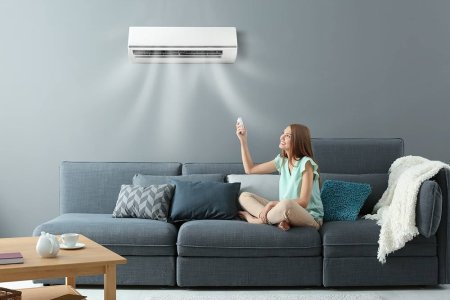Is your AC quietly messing with your health? Why a little maintenance might go a long way
- Replies 0
Sometimes, comfort can come with invisible costs.
Many of us have come to rely on chilled indoor air as the ultimate summer escape.
It’s easy to forget that this modern luxury is doing more than cooling—it might also be subtly influencing your health.
Before reaching for that thermostat dial, it’s worth asking: Is your home’s air actually helping you...or hurting you?
Air conditioning wasn’t always standard in homes. In fact, during the 19th century, doctors believed fresh outdoor air helped protect against respiratory illness—especially tuberculosis. By the 1960s, things shifted, and people began spending more time indoors, especially as AC use soared.
Today, we’re part of what experts call the "indoor generation," with some people spending up to 90% of their time inside.

The impact of AC goes far beyond just keeping you cool. During dangerous heat waves, it can literally save lives, particularly for seniors and those with medical conditions. Heat-related deaths in the US have doubled since 1999, making access to cooled air more than just a comfort—it’s become essential.
AC units also trap airborne irritants like pollen, dust, and fine particles from wildfire smoke or vehicle exhaust, offering relief to people with asthma or allergies.
Studies show that people living in homes with well-maintained AC systems have reduced risk of heart and lung conditions related to air pollution. Lower humidity is another bonus.
Dryer air reduces mold, dust mites, and bacteria—indoor triggers that can worsen lung conditions like COPD, asthma, or even lead to pneumonia in vulnerable individuals.
Also read: Stop overpaying! AC experts reveal the costly mistake adding hundreds to your energy bill
Over time, this dries out the lining of your nose, throat, and lungs. That dry irritation can lead to coughing, sore throats, congestion, and more. Some experts refer to this cluster of symptoms as “sick building syndrome.”
And there’s a more serious risk: dried-out airways may weaken your body’s natural defense system, making you more vulnerable to viruses and infections.
Dry indoor air also mimics the conditions of airplane cabins—where many people report feeling under the weather after long flights. The same effect can play out in your living room if your AC runs unchecked.
If levels dip below 40%, take a break from the AC. If they rise above 60%, it’s time to cool things down again.
Also read: Shocking reveal: Is your air conditioning making you sick?
Here’s what AC professionals and public health experts recommend:
Without proper ventilation, these chemicals can build up indoors, especially in tightly sealed homes. They’ve been linked to symptoms like headaches, irritation, hormone issues, and even chronic illness after long-term exposure.
To reduce indoor VOCs:
Some experts compare indoor spaces to biological systems. Like the human body, your home has its own “microbiome”—a mix of bacteria, fungi, and other organisms. Keeping your AC clean and humidity levels optimal supports a healthy, diverse balance of these microbes.
VOCs, on the other hand, can damage that balance and promote the growth of unhealthy bacteria.
Consumer-grade VOC monitors exist but may not detect all harmful compounds—so stick to basic prevention strategies. Even a simple humidity gauge, when paired with consistent AC upkeep, can protect your lungs and help you breathe easier.
Read next: This simple trick could slash your energy bill by $38 every month—Find out how!

Have you had your own AC wake-up call? Maybe you’ve solved your indoor air issues—or are still searching for solutions. Drop your stories and questions below.
Many of us have come to rely on chilled indoor air as the ultimate summer escape.
It’s easy to forget that this modern luxury is doing more than cooling—it might also be subtly influencing your health.
Before reaching for that thermostat dial, it’s worth asking: Is your home’s air actually helping you...or hurting you?
Air conditioning wasn’t always standard in homes. In fact, during the 19th century, doctors believed fresh outdoor air helped protect against respiratory illness—especially tuberculosis. By the 1960s, things shifted, and people began spending more time indoors, especially as AC use soared.
Today, we’re part of what experts call the "indoor generation," with some people spending up to 90% of their time inside.

It’s easy to forget that this modern luxury is doing more than cooling—it might also be subtly influencing your health. Image Source: Amazon
The impact of AC goes far beyond just keeping you cool. During dangerous heat waves, it can literally save lives, particularly for seniors and those with medical conditions. Heat-related deaths in the US have doubled since 1999, making access to cooled air more than just a comfort—it’s become essential.
AC units also trap airborne irritants like pollen, dust, and fine particles from wildfire smoke or vehicle exhaust, offering relief to people with asthma or allergies.
Cleaner, drier air—and why that matters
Well-functioning AC systems act like indoor air filters. When the AC runs, it helps reduce exposure to particles known as PM2.5, which are so small they can sneak into your bloodstream. These particles come from pollution outside, but once inside, they’re harder to get rid of without help from filtration.Studies show that people living in homes with well-maintained AC systems have reduced risk of heart and lung conditions related to air pollution. Lower humidity is another bonus.
Dryer air reduces mold, dust mites, and bacteria—indoor triggers that can worsen lung conditions like COPD, asthma, or even lead to pneumonia in vulnerable individuals.
Also read: Stop overpaying! AC experts reveal the costly mistake adding hundreds to your energy bill
When cool air starts causing hot problems
But like any system, balance matters. Cranking the AC too long or too cold can dry out your indoor environment to unhealthy levels. When air is too dry, your body adds moisture to it with every breath—and loses that moisture with every exhale.Over time, this dries out the lining of your nose, throat, and lungs. That dry irritation can lead to coughing, sore throats, congestion, and more. Some experts refer to this cluster of symptoms as “sick building syndrome.”
And there’s a more serious risk: dried-out airways may weaken your body’s natural defense system, making you more vulnerable to viruses and infections.
Dry indoor air also mimics the conditions of airplane cabins—where many people report feeling under the weather after long flights. The same effect can play out in your living room if your AC runs unchecked.
What’s the safe zone for indoor air?
Experts recommend keeping your indoor humidity between 40% and 60%. Anything outside that range can invite problems—from mold and mildew to aggravated respiratory issues. A simple humidity monitor, or hygrometer, can help you keep track.If levels dip below 40%, take a break from the AC. If they rise above 60%, it’s time to cool things down again.
Also read: Shocking reveal: Is your air conditioning making you sick?
If you forget the filters, your AC could turn against you
A poorly maintained AC unit may circulate more than just cold air. Dirty filters and neglected coils can become breeding grounds for bacteria, mold, and allergens—blowing harmful particles into every room.Here’s what AC professionals and public health experts recommend:
- Replace filters every 1–2 months during high usage.
- Use filters with a MERV rating of 11 or 13 for better protection against pollutants.
- Schedule a yearly inspection with a certified HVAC technician—even if your unit seems to be working fine.
- Install UV lights inside your AC system to reduce microbial growth. Just make sure they’re certified by UL or ETL for safety.
- Deep-clean window units before reinstalling them for summer—mold and dust can accumulate while in storage.
When clean air hides chemical risks
There’s one area where your AC won’t help—and it could even make things worse: VOCs. Volatile organic compounds are chemical pollutants released by everyday items like furniture, cleaners, and artificial air fresheners.Without proper ventilation, these chemicals can build up indoors, especially in tightly sealed homes. They’ve been linked to symptoms like headaches, irritation, hormone issues, and even chronic illness after long-term exposure.
To reduce indoor VOCs:
- Open windows from time to time to let fresh air flush out built-up chemicals.
- Use a HEPA air purifier with a carbon filter to trap VOCs and small particles like PM2.5.
- Choose low-VOC household products and go easy on air fresheners.
Some experts compare indoor spaces to biological systems. Like the human body, your home has its own “microbiome”—a mix of bacteria, fungi, and other organisms. Keeping your AC clean and humidity levels optimal supports a healthy, diverse balance of these microbes.
VOCs, on the other hand, can damage that balance and promote the growth of unhealthy bacteria.
Every home has its own fingerprint
No two homes are the same. Some trap pollutants inside due to tight construction, while others let in too much outdoor air. If you’re curious about your home’s air quality, you can buy a monitor for particles like PM2.5. These are becoming more accurate and affordable for everyday use.Consumer-grade VOC monitors exist but may not detect all harmful compounds—so stick to basic prevention strategies. Even a simple humidity gauge, when paired with consistent AC upkeep, can protect your lungs and help you breathe easier.
Read next: This simple trick could slash your energy bill by $38 every month—Find out how!
Key Takeaways
- Air conditioning offers vital health benefits, such as reducing heat-related death and filtering out harmful air pollution like PM2.5.
- Overuse of AC can dry out indoor air, irritating respiratory passages and weakening natural defenses against illness.
- Keeping indoor humidity between 40% and 60% and regularly maintaining your AC system are essential steps for protecting indoor air quality.
- AC units do not remove harmful indoor VOCs—ventilation and HEPA air purifiers with carbon filters are needed to reduce chemical exposure.






